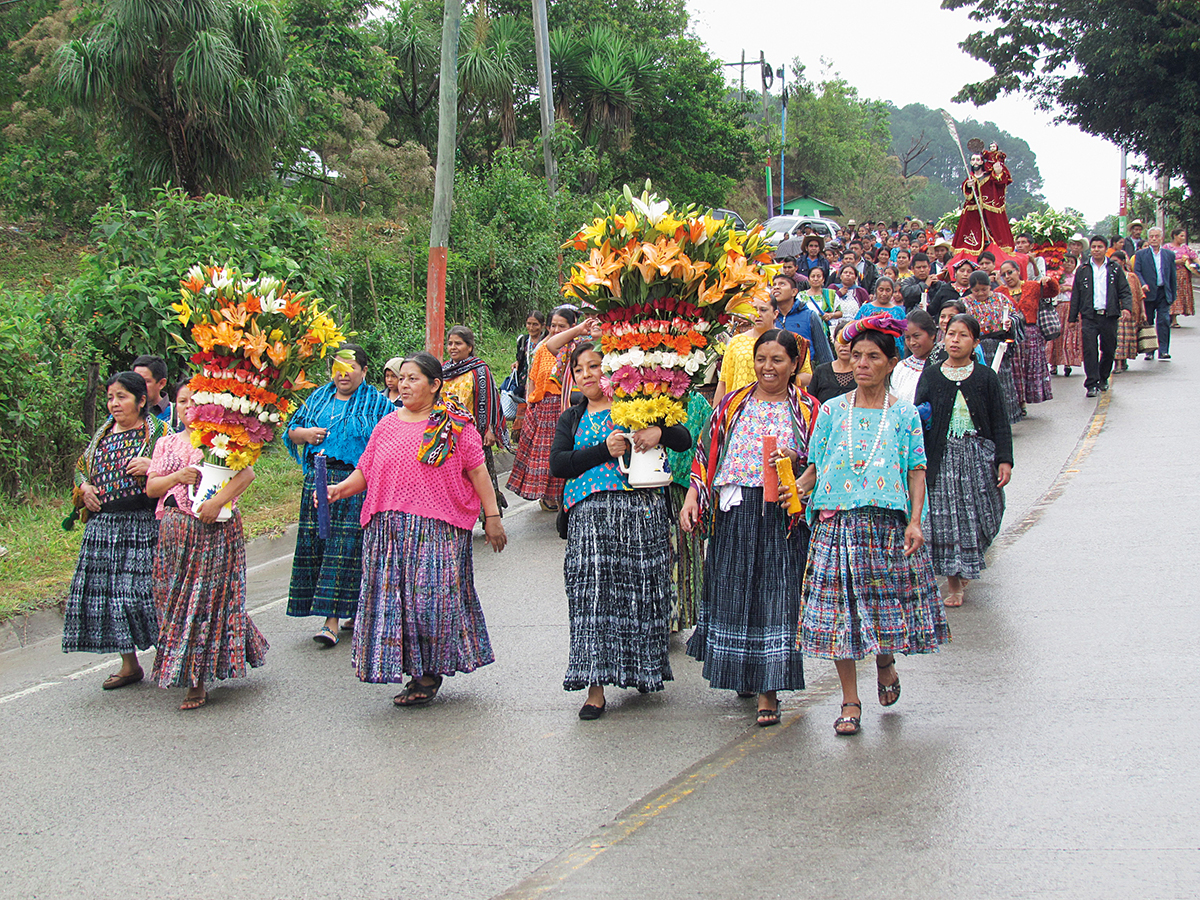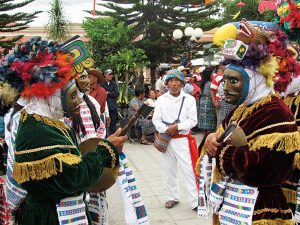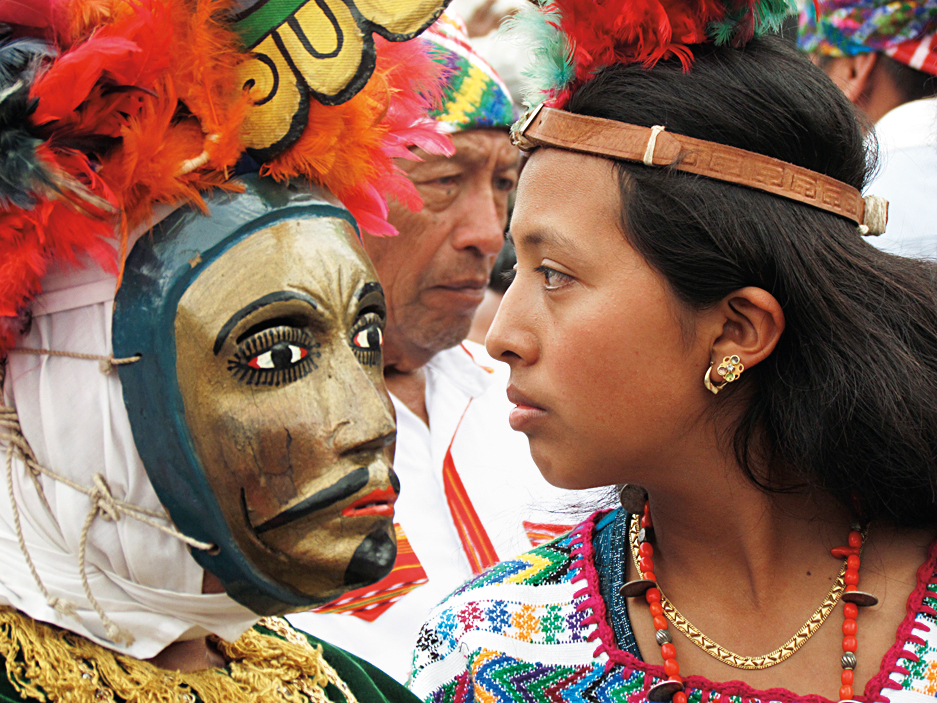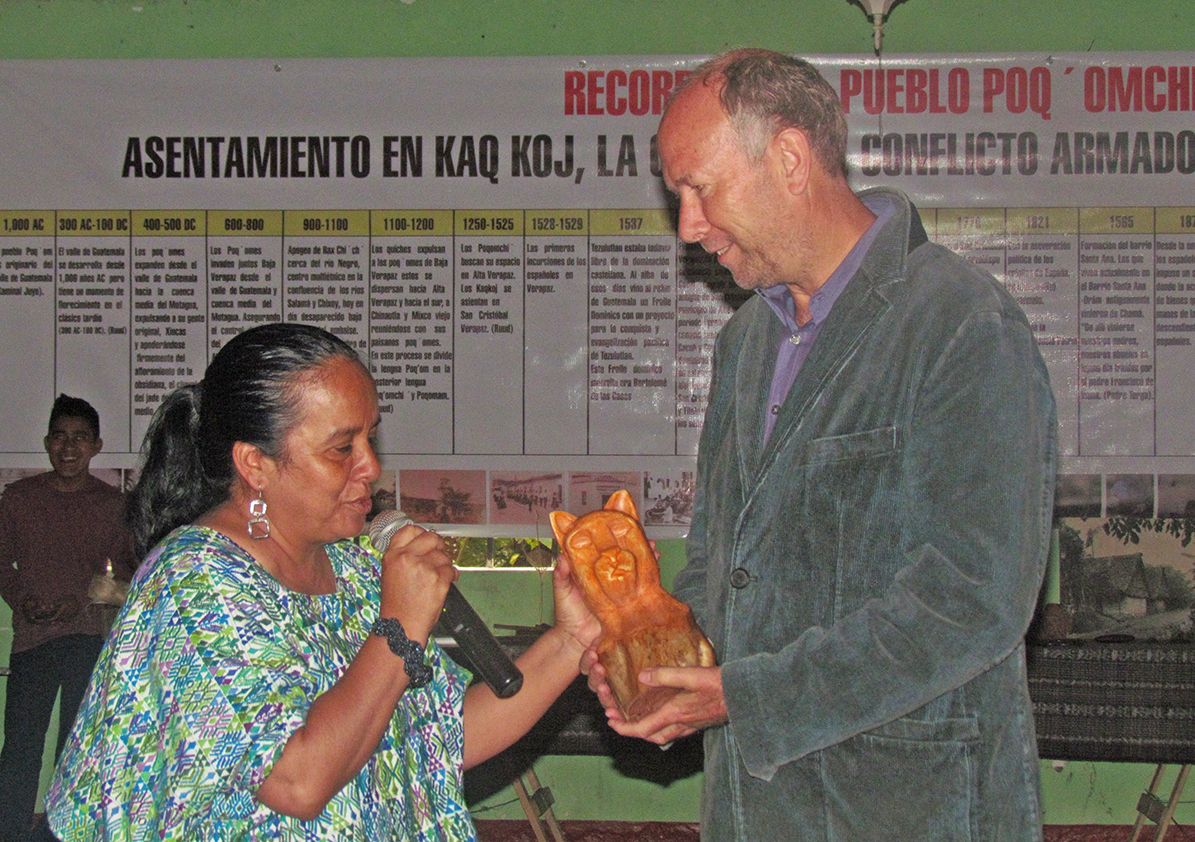
BY SUSANNA SHARPE
It is hard not to feel moved when talking to Ruud van Akkeren about his research. In such a conversation, it quickly becomes clear that Van Akkeren has his own nuanced, and possibly revolutionary, way of understanding Maya past and present in Guatemala, and that he doesn’t always see eye to eye with other Maya scholars.
Van Akkeren is an ethno-historian who has published extensively on indigenous documents such as the three best-known Highland Maya texts, Popol Wuj, Rabinal Achi, and Memorial de Sololá. (The first two were written in K’iche’ and the third in Kaqchikel, both of which Van Akkeren is able to translate himself.) As a preface to our conversation, he explains a few basics about Maya studies. Most Mayanists study the well-known Classic Lowland Maya sites and their history—sites such as Tikal. By comparison, there is much less funding available for the study of Highland Maya sites; as a consequence, their ancient inhabitants are far less understood. Furthermore, many Maya scholars deny the connection between Lowland and Highland Maya. While Van Akkeren acknowledges that Lowland development took place on a larger scale than in contemporary Highland sites, his work has shown that there was nevertheless an ongoing connection among Maya through shared lineages. “The Lowland Maya went shopping in the Highlands,” he says, noting that obsidian, the material used in weaponry, was mined in the Highlands. Other luxury items used by ruling elites, such as jade and quetzal feathers, were also sought in the Highlands.
As a teacher in Guatemala, Van Akkeren passionately shares his knowledge about the ancient Maya with present-day Maya, and furthers his own education by learning from contemporary Maya descendants as he continues to try to understand their ancestors. His twenty years of working with present-day Mayas in the field informs certain of his scholarly concerns: “We need to be careful not to end up with a Mayanist view, rather than a Maya view, of Maya history and religion,” he warns.
Rabinal Achi, Past and Present
Van Akkeren’s background is in both anthropology and theater. Through his love of spectacle and performance, he was drawn to the Rabinal Achi, a Maya dance-drama based on the creation myth. Its yearly enactment, which was the subject of his doctoral dissertation, takes place in the Guatemalan Highland town of Rabinal and dates to pre-Hispanic times. (The K’iche’ text of Rabinal Achi was recorded on paper in the sixteenth century by colonial scribes, but its existence in the oral tradition predates any written document.) Although the performance date coincides with the Catholic celebration of San Pablo, on January 25, the Rabinal Achi has deep roots in the Maya past. Van Akkeren says it was originally performed at the end of important 13-year and 52-year calendrical cycles.

Still performed in the original K’iche’, the Rabinal Achi is acted out today in the small town of Rabinal by native speakers of the Achi Maya language, dressed in elaborate masks and costumes. However, Van Akkeren says he realized that many of the spectators barely understand what is being said, or the context and history of the performance. In fact, in the course of living in Rabinal, Van Akkeren realized that “many people in Guatemala don’t know much about their own history.” He describes a national disconnect, whereby many of the country’s non-Maya elites have little interest in the rich Highland Maya history, while simultaneously disparaging actual living Maya people, who, he strongly believes, still carry a connection to their forebears.
This disconnect, and the lack of historical knowledge among present-day Maya, led Van Akkeren to his current work: “to reconstruct Maya history with Maya people in Maya towns.” He works with adults—among them local educators, university students, NGO officials, catechists, and spiritual guides—giving courses, conducting fieldwork, and, most recently, co-authoring written materials on ancient Maya culture.
Teaching and Learning from Present-Day Maya
Through a collaboration with the NGO Verdad y Vida over the last six years, Van Akkeren offers a multi-week course that includes classroom teaching, visits to historic sites and museums, and visits to sites where recent and ancient history coincide. The purpose of Verdad y Vida is to restore the self-esteem of people who suffered during Guatemala’s civil war (1960–1996) by supporting the recovery of historical memory and reconstructing a connection with ancient roots. This is where Van Akkeren’s role as a teacher comes in: his most important task is “giving back the history to the people,” he says. “Knowing the ancient history gives pride, a counterbalance to the more recent tragedies that allows people to heal.”

But Van Akkeren’s work goes two ways, as he also receives from the many Maya with whom he collaborates. Talking to present-day Maya about the past is, to him, “probably one of the best ways to study Mayas.” He continues, “It is essential to study and understand present-day Maya culture in order to be able to reconstruct the ancient culture and history of the Mayas.”
His recent work focuses on the pre-Hispanic history of the Highland municipality of San Cristóbal Verapaz and collaboration with Poq’omchi’-speaking people, one of more than a dozen Highland Maya groups. In 2013–2014, Van Akkeren led a series of workshops for local residents that produced El rojizo amanecer del puma: sucinta historia prehispánica de San Cristóbal Verapaz, a multi-authored compilation of essays on the pre-Hispanic history of San Cristóbal. The title of this book owes itself to the fact that during colonial times, San Cristóbal was known as San Cristóbal Kaqkoj, or “Puma.” The Kaqkoj/Puma was the founding lineage of the town.
The short book is a precursor to a lengthier forthcoming volume on the subject of San Cristóbal’s ancient past. It is also the first in which Van Akkeren has asked local participants and collaborators, adults from all walks of life, to write the chapters themselves. It represents “a new jump in the way I’m working,” he says.
In the introduction to El rojizo amanecer, Van Akkeren laments the scant presence of Maya history in the Guatemalan school curriculum, and notes that when this history is taught, the focus is almost exclusively on the Lowland Maya of the Classic period (A.D. 200–900) in El Petén. Highland Maya groups and their past are mostly neglected.

Teaching and learning about their history represents a first step in righting this wrong. Participating in its telling represents another. “After a first workshop on the ancient history of the Poq’omchi’ people, participants were anxious to gather this material in a publication, a serious book about the pre-Hispanic history of the Poq’om, useful for future generations and educational institutions,” says Van Akkeren. The novelty of El rojizo amanecer “is the proposal that the participants are also the researchers of their own past and that they should write this part of the book. Thus, not only is history returned to people, so are the tools for investigating that history” (El rojizo amanecer del puma, 5).
Central to the text of El rojizo amanecer and the forthcoming longer book is Van Akkeren’s own research on the origin of the Poq’om people—present-day Poq’omchi’ and Poq’omam people who share a common ancestry and speak related languages. This line of inquiry led him to the ancient Maya city of Kaminal Juyu, an expansive archaeological site located beneath and around Guatemala City, in the Valley of Guatemala. His thesis about the origins of Kaminal Juyu and its inhabitants contrasts with much of the accepted wisdom about this site. Based on archaeological and anthropological evidence, Van Akkeren posits that Poq’om people were the founders of Kaminal Juyu.
As Van Akkeren began to address themes of ancient Maya imagery in Kaminal Juyu era in his workshops, he said, “it was fascinating to find that a city that had its heyday 2,000 years ago left traces of knowledge that are still present in today’s Poq’omchi’ people in Verapaz.” An obvious example is the patron saint of San Cristóbal Verapaz, who is depicted as carrying the baby Jesus while crossing a river. “This is conceptually linked with an ancient Maya patron deity who is depicted in statuary and murals as saving the baby maize god from a river,” claims Van Akkeren.
A Semester in Austin Comes to a Close
Ruud van Akkeren taught the graduate seminar Exploring Maya Thought at LLILAS Benson. The course examined indigenous documents and introduced Guatemalan Highland history, connecting it with the rest of Mesoamerica.
A large part of the course focused on the Popol Wuj, a mythical-historical K’iche’ text transcribed in colonial times. One of the main points about the readings in the seminar was this: “You need to know who wrote the text in order to understand it.” The first classes were about the authors of the Popol Wuj and Van Akkeren’s finding that they are descendants of a Classic-period Lowland Maya lineage.
The seminar then turned to the text’s content: “We explored one of the most important myths of the Popol Wuj, which takes place in the Maya underworld, or Xibalba. This leads to the discovery of the two principal paradigms in Maya and Mesoamerican creation, which center on food (corn) and light (sun). These are viewed as complementary by Mesoamericans, with maize being connected to the feminine domain and sun being the primordial warrior in the masculine domain. Most of the mythology, iconography, and oral traditions center around these two concepts—solar god and maize god.”
The course also focused on the dissemination of these concepts throughout Mesoamerica along trade routes, which connected the Highlands with Teotihuacan. The prevalence of these concepts prompts an essential question for Van Akkeren: “I want to know the people who brought these common paradigms from one place to another in Mesoamerica. The prime movers in ancient times were long-distance merchants, and there are specific lineages organized in the merchant guilds that disseminated these concepts. It’s fascinating, for example, to find that Maya people from Kaminal Juyu were buried in the Pyramid of the Moon, one of Teotihuacan’s principal sanctuaries.”
Archaeologist Adriana Linares, a Guatemalan doctoral student at LLILAS, took Van Akkeren’s graduate seminar. What she appreciated most was Van Akkeren’s interdisciplinary approach, and the fact that ethno-historical documents were brought into the study of Maya archaeology: “It was an integrated study, talking about ancient history that flows, about people, family, and lineages—communicating that there is a constant interaction that involves all of these factors.” Linares’s view of ancient history emphasizes processes involving people instead of merely objects and places of grandeur. But she says that archaeologists who wish to work differently in their field, introducing alternative interpretations that sometimes imply more continuity with the present, face the fundamental challenge of finding enough credible evidence to back up their theories.
Ruud van Akkeren returns to his home in Guatemala to continue facing such challenges and to pursue his collaboration with present-day Maya in order to understand the past.
Ruud van Akkeren is an associate researcher affiliated with La Universidad del Valle in Guatemala. He is the author of numerous scholarly articles and books, and of the historical novel La danza del tambor. He is currently completing a book on the ethno-history of Kaminal Juyu. He lives in Cobán, Alta Verapaz, Guatemala.
Susanna Sharpe is the communications coordinator at LLILAS Benson Latin American Studies and Collections, and the editor of Portal.
Editor’s note: Despite a general trend among Mayanists to write Poqomchi’, Poqomam, and Poqom without a glottal stop (apostrophe) after the letter q, Van Akkeren argues differently. The spelling in this article reflects his preference.
